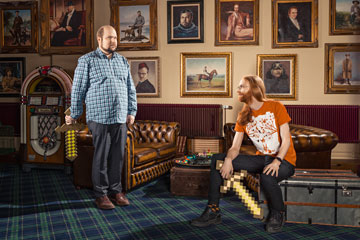
Persson, far left, and Bergensten, the minds behind Minecraft, brandishing the game's pixelated swords
(3 of 6)
What those players were so enthusiastic about was a game that was both simple and deep. Minecraft, Notch says, "has a lot of complexity--but most of that complexity is optional." There are two primary ways to play. In Survival Mode, you can't even begin building stuff out of blocks made of various materials, from iron to sandstone to quartz, until you've fashioned your own tools and mined, found or otherwise acquired the blocks. Assuming you're not killed on your first night by a horde of monsters. No matter how adept you are, building an accurate copy of something like the Arc de Triomphe in Survival Mode might be impossible.
That's why the game also offers Creative Mode, which eliminates risks to the player's well-being, adds the ability to fly and provides an unlimited supply of construction materials. Essentially, it's the world's greatest box of Lego pieces. For the record, Notch says he wasn't thinking about the iconic Danish building toy when he created Minecraft but concedes that it was probably a subconscious influence, since he played a lot of Lego as a kid.
In either mode, the world of Minecraft doesn't look that much like our world. Everything is rendered in a first-person view but with a low-resolution, pixelated effect, a little as if it were the most impressive new game of 1988. Players are represented by a default character nicknamed Steve--a swarthy blockhead with no neck, hands or feet. Even the monsters are too cute to be monstrous. Minecraft's graphics are so rudimentary, Notch says, because they were the best he could muster when he was getting started. But his lack of artistic ability turned into one of the game's defining traits. "A tree doesn't look like a tree, but you know it's a tree. It makes it feel more real, because a larger part of it takes place in your imagination."
In November 2011, notch officially completed work on Minecraft 1.0. Then he did something unexpected: he fired himself just as his creation was becoming a huge success. "I played it for too many hundreds of hours," he remembers. "After a couple of years at a job, I get bored at it and want to start something new. It starts to get frustrating after a while even if it's fun."
Notch began hatching plans for a new game and turned over primary responsibility for the game to his right-hand man, Jens Bergensten, 34, a ponytailed redhead better known in the Minecraft community as Jeb. Conspiracy theorists may have trouble accepting the notion that Notch truly handed off Minecraft supremacy to Jeb while remaining on the Mojang premises. (Obvious parallel: Pope Benedict XVI and Pope Francis cohabiting in the Vatican.) But both men insisted to me that the transfer of power has been real and effective. "When [Notch] stepped down as lead developer, he stopped playing Minecraft, more or less," says Jeb. "He was afraid that if he came with suggestions for the game, he'd be commanding what we should do."
